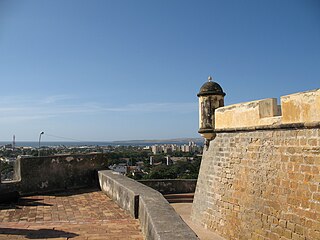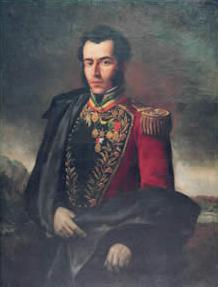See also
- Antonio José de Sucre Airport, an airport in Cumaná, Venezuela
- Antonio José de Sucre Municipality, a Venezuelan municipality in the state of Barinas
Antonio José may refer to:

Antonio José de Sucre y Alcalá, known as the "Gran Mariscal de Ayacucho", was a Venezuelan general and politician who served as the president of Bolivia from 1825 to 1828. A close friend and associate of Simón Bolívar, he was one of the primary leaders of South America's struggle for independence from the Spanish Empire.
Luis is a given name. It is the Spanish form of the originally Germanic name Hludowig or Chlodovech. Other Iberian Romance languages have comparable forms: Luís in Portuguese and Galician, Lluís in Aragonese and Catalan, while Luiz is archaic in Portugal, but common in Brazil.

Pacheco is a Portuguese and Spanish surname deriving from the Latin Paccieaus as well as the Basque Patxi, a variation of Francisco. It may refer to:
Sucre is the constitutional capital of Bolivia.

Cumaná is the capital city of Venezuela's Sucre State. It is located 402 kilometres (250 mi) east of Caracas. Cumaná was one of the first cities founded by Spain in the mainland Americas and is the oldest continuously-inhabited Hispanic-established city in South America. Its early history includes several successful counters by the indigenous people of the area who were attempting to prevent Spanish incursion into their land, resulting in the city being refounded several times. The municipality of Sucre, which includes the capital city, Cumaná, had a population of 358,919 at the 2011 Census; the latest estimate is 423,546.
José is a predominantly Spanish and Portuguese form of the given name Joseph. While spelled alike, this name is pronounced very differently in each of the two languages: Spanish [xoˈse]; Portuguese [ʒuˈzɛ].

The Battle of Ayacucho was a decisive military encounter during the Peruvian War of Independence. This battle secured the independence of Peru and ensured independence for the rest of South America. In Peru it is considered the end of the Spanish American wars of independence in this country, although the campaign of Antonio José de Sucre continued through 1825 in Upper Peru and the siege of the fortresses Chiloé and Callao eventually ended in 1826.

The Sucre Family is a prominent political family of Venezuela.

The National Pantheon of Venezuela is a final resting place for national heroes. The Pantheon was created in the 1870s on the site of the ruined Santísima Trinidad church from 1744 on the northern edge of the old town of Caracas, Venezuela.

José María Córdova Muñoz, also known as the "Hero of Ayacucho", was a General of the Colombian army during the Independence War of Colombia, Perú, and Bolivia from Spain.
Simón Bolívar (1783–1830) was the Venezuelan leader of independence movements in several South American countries.

Mariscal Sucre Airport is an airport in the Aragua state of Venezuela, serving the city of Maracay. The airport is on the northeastern shore of Lake Valencia also named Los Tacariguas Lake. The airport is named in honor of Antonio José de Sucre, a leader of the Venezuelan War of Independence and the second president of Bolivia. Runway 11/29 length does not include an 85 metres (279 ft) displaced threshold for Runway 29. Runway 06/24 has a 53 metres (174 ft) paved overrun on each end.

José María Pérez de Urdininea was a Bolivian military officer and statesman who served as the third president of Bolivia in 1828. He was the first Bolivian president to be born in Bolivia itself. He fought with the patriots against the Argentines in Peru. Despite being President for only three months, Pérez held a number of important positions in the Bolivian government including Minister of War between 1841 and 1847.

Pedro Blanco Soto was a Bolivian soldier and politician, he was president of the Republic of Alto Peru, an unrecognized independent entity that emerged in the limits of the department of La Paz and, which claimed the territory of the Republic of Bolivia. He held the position for a short time before being killed by his opponents in a convent called La Recoletta in Sucre on New Year's Day 1829. A small plaque now marks the spot in the Museo de la Recoletta. He was well known for his pro-Peru stance and this is generally the reason attributed to his assassination. He was also a distinguished officer during the Peruvian War of Independence.
José Antonio is a common pairing of personal names in Spanish and Portuguese, and may refer to:

The October 9 Revolution was a successful revolt against the Spanish Empire in Guayaquil on October 9, 1820. It was led by the General Antonio José de Sucre and directed by Simón Bolívar. The revolt established a revolutionary junta and created the Free Province of Guayaquil, an independent state. The independence of Guayaquil revived the war of independence of the Real Audiencia de Quito as part of the Spanish American wars of independence. Prominent events in the revolution include the uprising of the Spanish garrison in the city of Guayaquil and the control of the Pacific by the Liberating Expedition of Peru, under the command of José de San Martín.